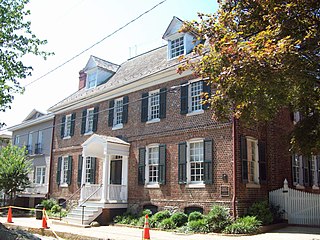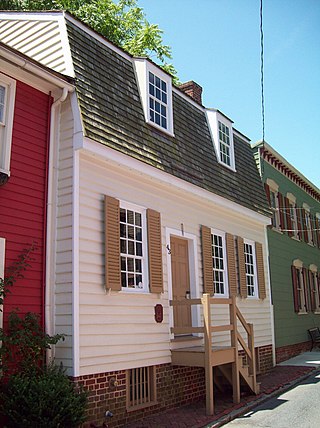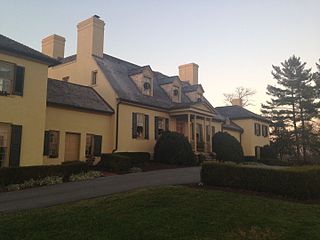
Anne Arundel County, also notated as AA or A.A. County, is located in the U.S. state of Maryland. As of the 2020 United States census, its population was 588,261, an increase of just under 10% since 2010. Its county seat is Annapolis, which is also the capital of the state. The county is named for Anne Arundell, Lady Baltimore, a member of the ancient family of Arundells in Cornwall, England, and the wife of Cecilius Calvert, 2nd Baron Baltimore (1605–1675), founder and first lord proprietor of the colony Province of Maryland. The county is part of the Central Maryland region of the state. Anne Arundel County is included in the Washington–Baltimore–Arlington combined statistical area.

Annapolis is the capital of the U.S. state of Maryland. It is the county seat of Anne Arundel County and its only incorporated city. Situated on the Chesapeake Bay at the mouth of the Severn River, 25 miles (40 km) south of Baltimore and about 30 miles (50 km) east of Washington, D.C., Annapolis forms part of the Baltimore–Washington metropolitan area. The 2020 census recorded its population as 40,812, an increase of 6.3% since 2010.

The Severn River is a tidal estuary 14 miles (23 km) long, located in Anne Arundel County in the U.S. state of Maryland, south of the Magothy River and north of the South River.

Maryland Route 450 is a state highway in the U.S. state of Maryland. The state highway runs 30.19 miles (48.59 km) from U.S. Route 1 Alternate in Bladensburg east to US 50/US 301 and MD 2 near Arnold. MD 450 forms a local complement to US 50 from near Washington, D.C. through Annapolis. In Prince George's County, the highway is a four- to six-lane divided highway that serves Bladensburg, Landover Hills, New Carrollton, Lanham, and Bowie. In Anne Arundel County, MD 450 connects Crofton with Parole and Annapolis with the portion of the county east of the Severn River. The highway serves as one of the main streets of Annapolis, including the state capital's historic core, and is the primary vehicular access to the U.S. Naval Academy.
Annapolis High School is an American high school located in the Parole census-designated place in Anne Arundel County, Maryland, United States, outside Annapolis. It is part of the Anne Arundel County Public Schools system and is accredited by the Middle States Association of Colleges and Schools. In 2013, Newsweek ranked Annapolis as one of the top 2,000 high schools in the country.

Government House,, is the official residence of the governor of Maryland. It is located on State Circle in the state capital town of Annapolis, Maryland. It is situated adjacent to / across State Circle from the historic Maryland State House and surrounding legislative buildings complex for the bicameral General Assembly of Maryland.

Annapolis National Cemetery is a United States National Cemetery located in the city of Annapolis, in Anne Arundel County, Maryland. It encompasses 4.1 acres (1.7 ha), and as of 2020, had over 3,100 interments. It is operated and maintained by the Baltimore National Cemetery.

The Hammond–Harwood House is a historic house museum at 19 Maryland Avenue in Annapolis, Maryland, USA. Built in 1774, is one of the premier colonial houses remaining in America from the British colonial period (1607–1776). It is the only existing work of colonial academic architecture that was principally designed from a plate in Andrea Palladio's I Quattro Libri dell'Architettura (1570). The house was designed by the architect William Buckland in 1773–1774 for wealthy farmer Matthias Hammond of Anne Arundel County, Maryland. It was modeled on the design of the Villa Pisani in Montagnana, Italy, as depicted in Book II, Chapter XIV of Palladio's work. It was designated a National Historic Landmark in 1960, and is now managed by a non-profit organization as a museum.
John Randall was an architect, American Revolutionary War soldier and officer, and was an early 19th-century mayor of Annapolis, Anne Arundel County, Maryland. He was also the Collector of the Port of Annapolis, which included responsibility for fortifying the harbor.

The William Brown House, also known as London Town Publik House or Londontowne Public House, is a former Colonial tavern located in the Historic London Town and Gardens museum complex in Woodland Beach, Anne Arundel County, Maryland. Completed in 1764, it is one of the best-preserved examples of a colonial-era brick tavern house. From 1828 to 1965 the structure was used as a county alms house. It was declared a National Historic Landmark in 1970.

The William Paca House is an 18th-century Georgian mansion in Annapolis, Maryland, United States. Founding Father William Paca was a signatory of the Declaration of Independence and a three-term Governor of Maryland. The house was built between 1763 and 1765 and its architecture was largely designed by Paca himself. The 2-acre (8,100 m2) walled garden, which includes a two-story summer house, has been restored to its original state.

The Brice House is, along with the Hammond-Harwood House and the William Paca House, one of three similar preserved 18th-century Georgian style brick houses in Annapolis, Maryland. Like the Paca and Hammond-Harwood houses, it is a five-part brick mansion with a large central block and flanking pavilions with connecting hyphens. Of the three, the Brice House's exterior is the most austere, giving its brickwork particular prominence. The Brice House was declared a National Historic Landmark in 1970.

The Chase–Lloyd House is a historic house at 22 Maryland Avenue in Annapolis, Maryland. Built in 1769–1774, it is one of the first brick three-story Georgian mansions to be built in the Thirteen Colonies, and is one of the finest examples of the style. Its interiors were designed by William Buckland.

Whitehall is a colonial home that was built beginning in 1764 near Annapolis in Anne Arundel County in the Province of Maryland by Horatio Sharpe, then the provincial governor of the British colony of Maryland.

The Peggy Stewart House, also known as the Rutland-Jenifer-Stone House, is a Georgian-style house in Annapolis, Maryland. Built between 1761 and 1764 by Thomas Rutland as a rental property, it was owned at various times by Thomas Stone and U.S. Founding Father Daniel of St. Thomas Jenifer. In October 1774 it was owned by Anthony Stewart, owner of the ship Peggy Stewart. It was listed in the National Register of Historic Places in 1973 for its associations with the burning of Anthony Stewart's ship, Peggy Stewart, as well as for its architectural significance as a mid- to late 18th century Georgian mansion. Furthermore, the dwelling was recognized as a National Historic Landmark for its associations with Jenifer and Stone, and for the thematic representation of politics and diplomacy during the American Revolution

John Callahan House, known previously as Pinkney-Callahan House when it was located on St. John Street, is a historic home in Annapolis, Maryland, United States. The brick home was constructed by John Callahan, a prominent and wealthy Annapolitan who served as the Register of the Western Shore Land Office between 1778 and 1803, around 1785–90. It has been moved twice in efforts to prevent its demolition. In 1900–01, the house was relocated to St. John's Street and then to its present site on Conduit Street in 1972. The home features an unusual gable-end principal façade and a largely intact Georgian/Federal interior finishes. It once served as St. John's College Infirmary.

Artisan's House is a historic home located at Annapolis, Maryland, United States. It is a 1+1⁄2-story frame house on a brick foundation representative of modest middle class dwellings of the 18th century. It was likely used as a barracks during the Revolutionary War. Because of this, it is also known as "Hogshead."

The Belmont Estate, now Belmont Manor and Historic Park, is a former plantation located at Elkridge, Howard County, Maryland, United States. Founded in the 1730s and known in the Colonial period as "Moore's Morning Choice", it was one of the earliest forced-labor farms in Howard County, Maryland. Its 1738 plantation house is one of the finest examples of Colonial Georgian architectural style in Maryland.
Burle's Town Land is a colonial archaeological site near Annapolis in Anne Arundel County, Maryland. It was the location of the homestead of Robert Burle, a surveyor who received a 100-acre (40 ha) patent in the area in 1663, including land that he may have been occupying somewhat earlier. Burle built a house and lived there until is death in 1675; his only child, a daughter, married and moved away in 1680, abandoning the property. The property is situated on a terrace above Mill Creek, and is now partly covered by a later cemetery. Archaeological digs have uncovered general outlines of Burle's house, although the evidence is somewhat compromised by grave digging activity above. The site has also yielded significant finds of Dutch ceramics. Burle's residence in the area is associated with the Puritan Providence Colony established across the Severn River where Annapolis is now located.
St. Margaret's is a suburb of Annapolis in Anne Arundel County, Maryland, United States on the scenic Broadneck Peninsula. The ZIP code is 21409.




















